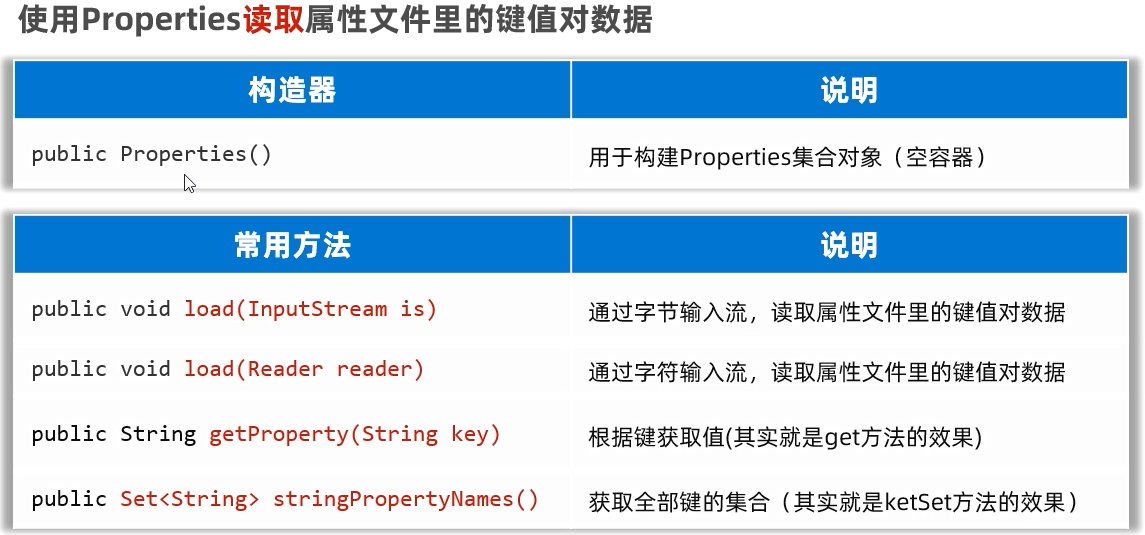Java-特殊文件、日志技术
目录
1.特殊文件和日志技术概述
1.1 特殊文件
1.2 日志技术
2.Properties
2.1读写Properties文件
2.2 案例
3.XML文件
3.1 概述
3.2 读取XML文件中的数据
3.3 XML的创建
3.4 补充:约束XML文件的编写
3.4.1 XML文档约束-DTD的使用(了解)
3.4.2 XML文档约束-schema的使用(了解)
4.日志技术
4.1 日志技术的体系结构
4.2 Logback日志技术快速入门
4.3 日志技术的核心配置文件
4.4 日志级别
1.特殊文件和日志技术概述
1.1 特殊文件
特殊文件在 Java 中是实现数据持久化、共享、配置管理以及性能优化的重要工具
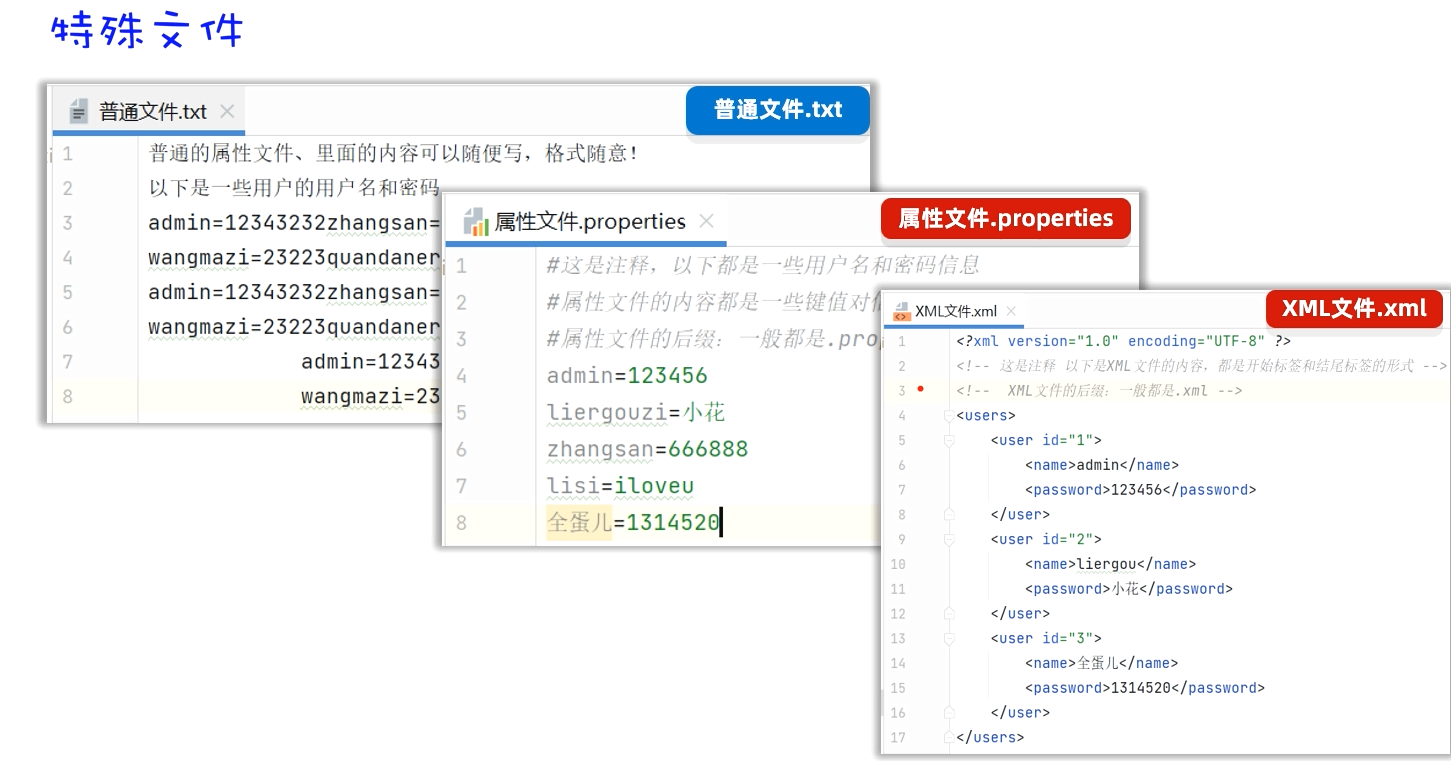

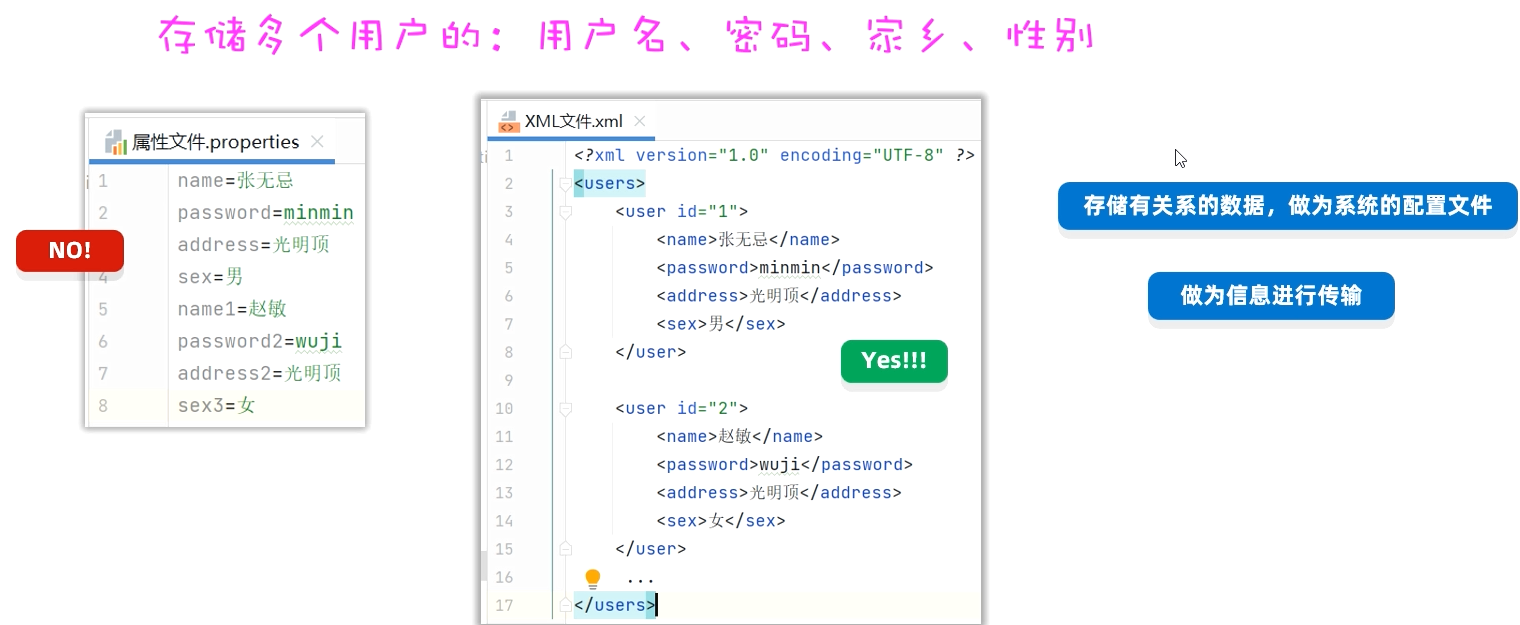 1.2 日志技术
1.2 日志技术
把程序运行的信息,记录到文件中,方便程序员定位bug、并了解程序员的执行情况等
2.Properties
2.1读写Properties文件
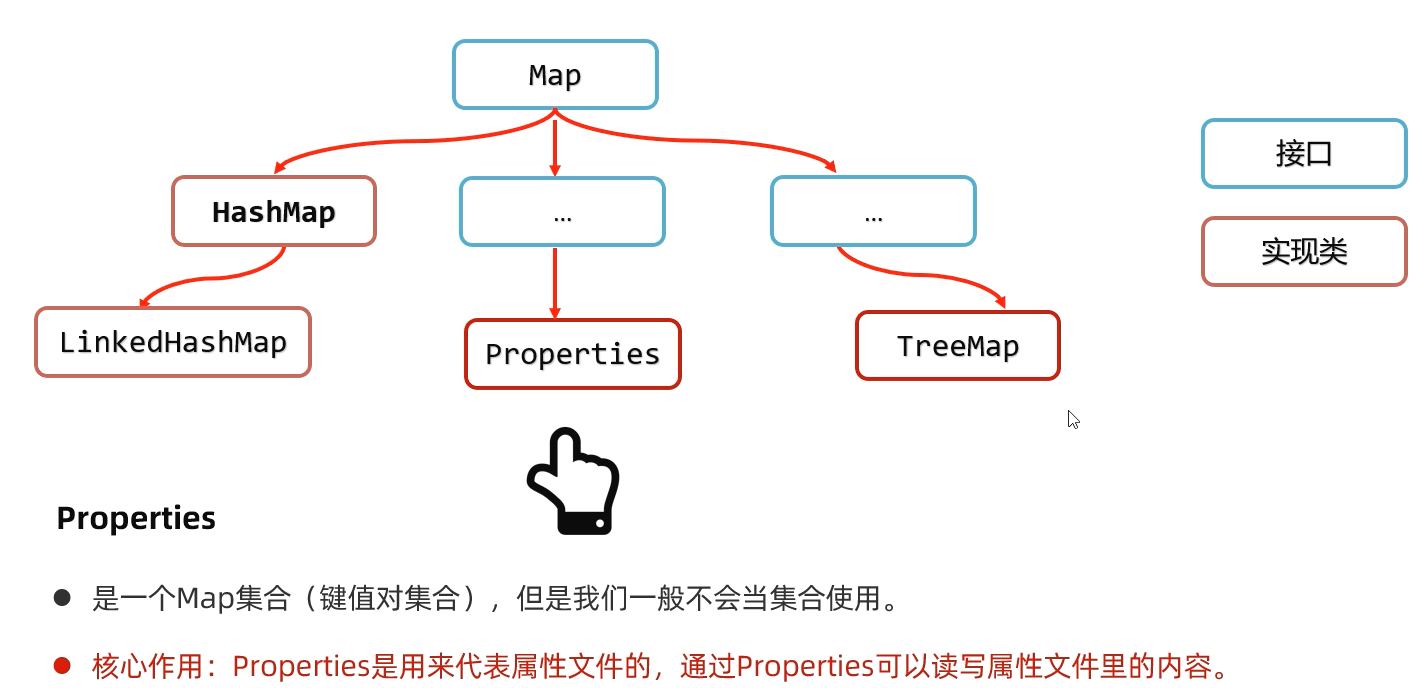
package com.itheima.d1_properties;import java.io.FileInputStream;
import java.util.Properties;
import java.util.Set;public class PropertiesDemo1 {public static void main(String[] args) throws Exception {// 目标:Properties读取属性文件中的键值对数据.// 1、创建属性集对象,代表一个属性文件Properties properties = new Properties();System.out.println(properties);// 2、加载属性文件信息到属性集对象中去。properties.load(new FileInputStream("day11-special-file-log-code\\src\\users.properties"));System.out.println(properties);// 根据键取值// System.out.println(properties.get("赵敏"));System.out.println(properties.getProperty("赵敏"));//Map可以用keySet取出所有的键//properties也可以用stringPropertyNames()取出所有的键Set<String> keys = properties.stringPropertyNames();for (String key : keys) {String value = properties.getProperty(key);System.out.println(key + "==>" + value);}// 3、遍历数据properties.forEach((k, v) -> {System.out.println(k + "===>" + v);});}
}
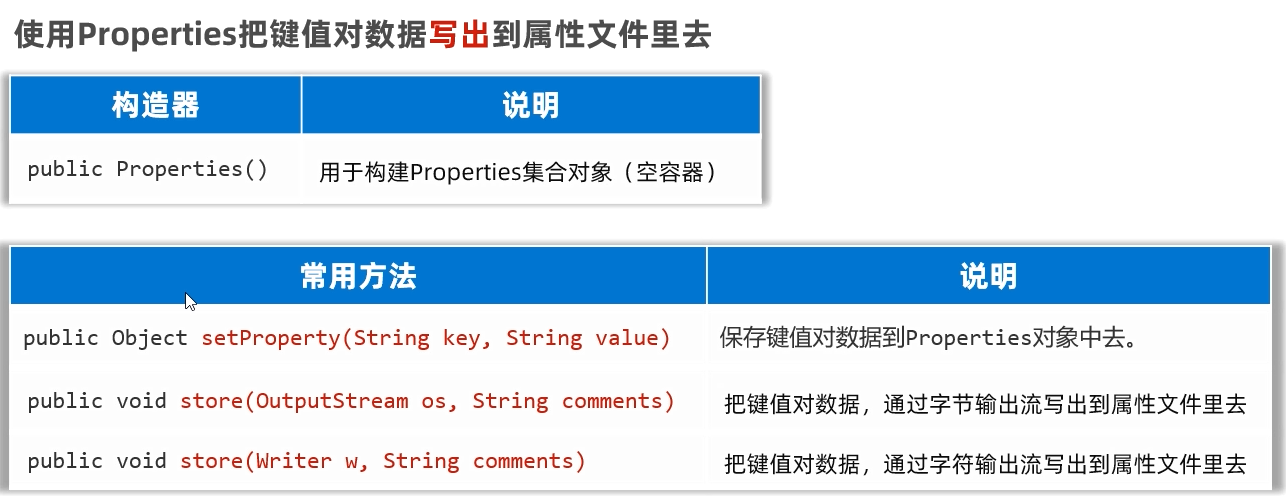
package com.itheima.d1_properties;import java.io.FileWriter;
import java.util.Properties;public class PropertiesDemo2 {public static void main(String[] args) throws Exception {// 目标:掌握使用Properties把键值对数据又写出去到属性文件中去。// 1、创建属性集对象Properties properties = new Properties();//properties.put("admin", "66666");properties.setProperty("admin", "66666");properties.setProperty("玄冥二老", "wangfei");properties.setProperty("金毛狮王", "成昆");properties.setProperty("小昭", "wuji");System.out.println(properties);// 2、存储到文件properties.store(new FileWriter("day11-special-file-log-code/src/users2.properties"),"i saved many users! give me 100!");}
}
2.2 案例
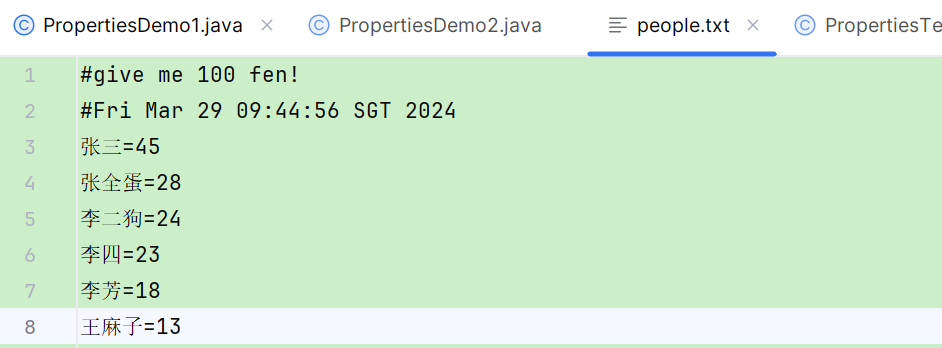
package com.itheima.d1_properties;import java.io.FileReader;
import java.io.FileWriter;
import java.util.Properties;public class PropertiesTest3 {public static void main(String[] args) throws Exception {// 1、创建Properties对象Properties properties = new Properties();// 2、加载属性文件中的键值对数据//用字节输入流可能会乱码,尽量用字符输入流properties.load(new FileReader("day11-special-file-log-code\\src\\people.txt"));// 3、判断是否存在李芳,存在把其值改成18if(properties.containsKey("李芳")){properties.setProperty("李芳", "18");}// 4、把属性文件对象,重新存入到属性文件中去。properties.store(new FileWriter("day11-special-file-log-code\\src\\people.txt"),"give me 100 fen!");}
}
3.XML文件
3.1 概述
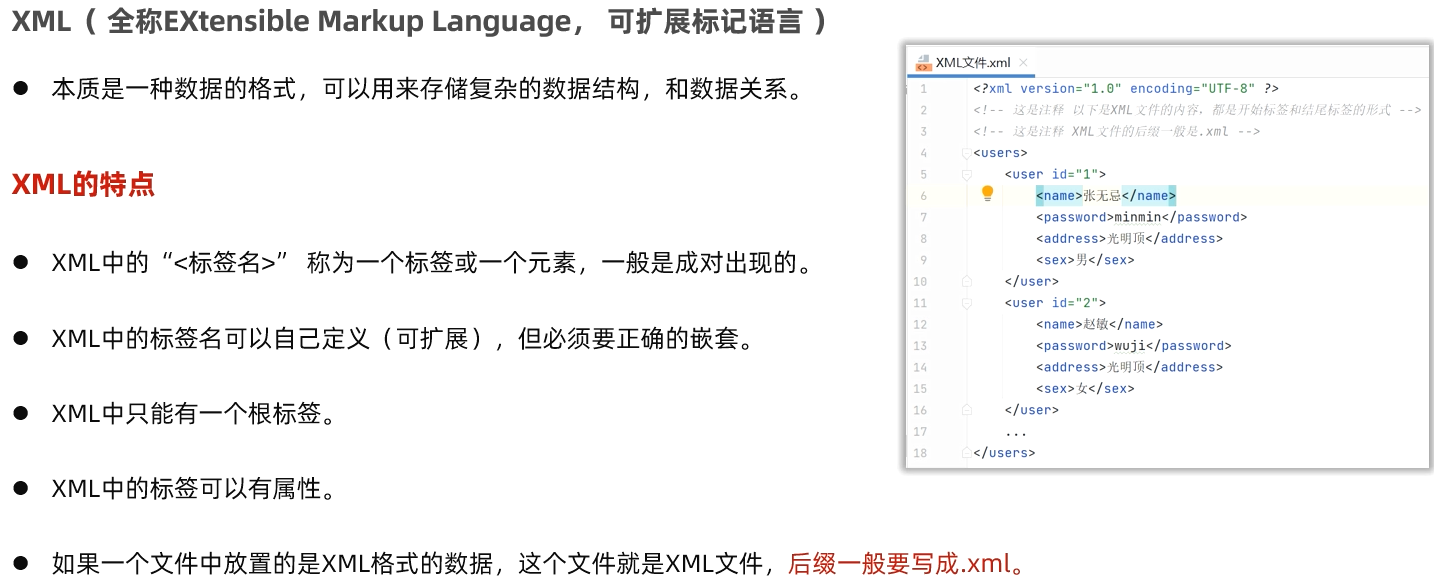
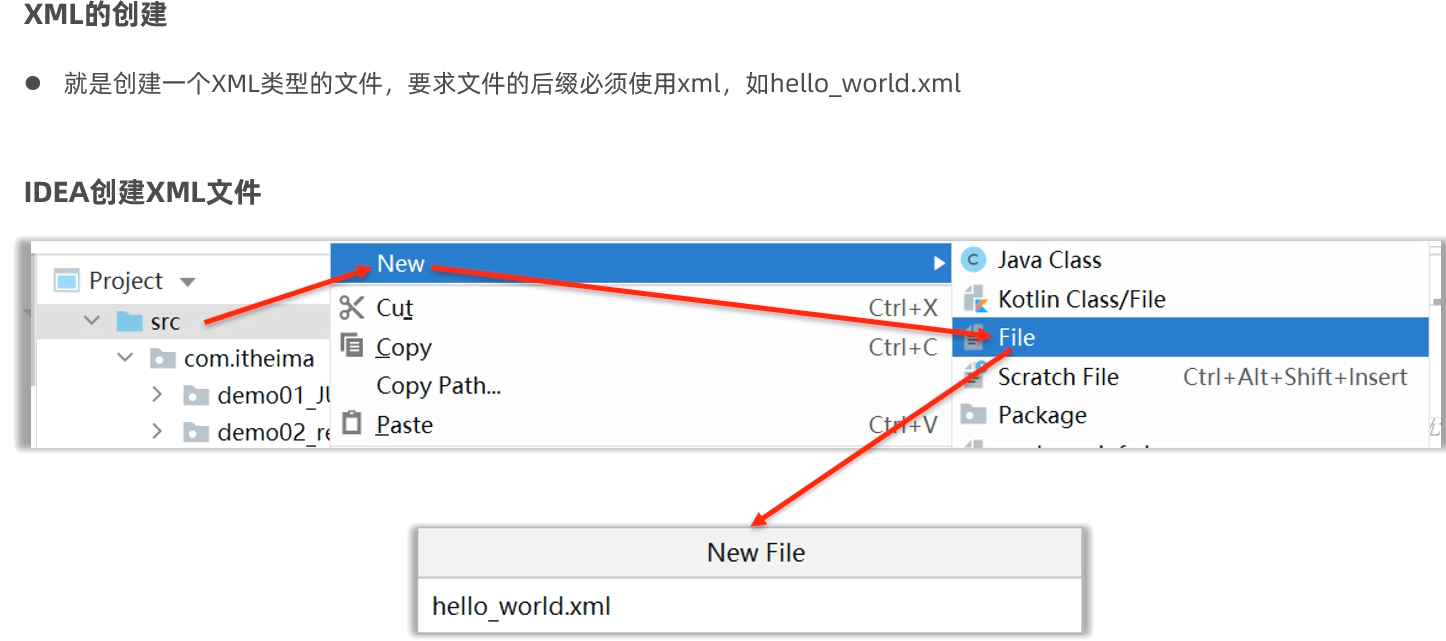
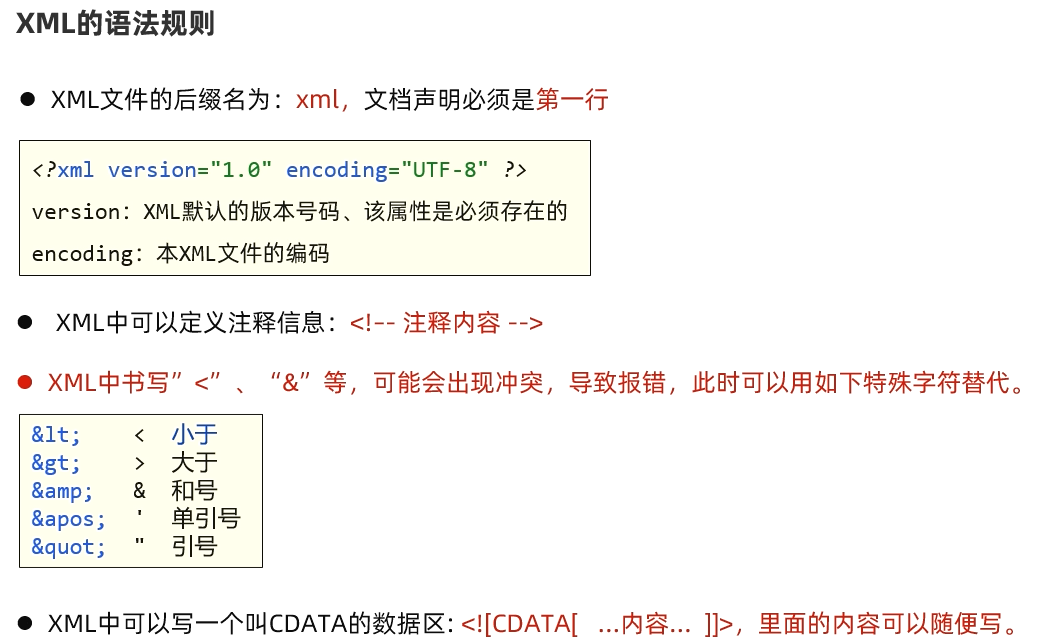
<?xml version="1.0" encoding="UTF-8" ?>
<!-- 以下是一个新的xml的内容 -->
<users><user id="1"><name>张全蛋</name><sex>男</sex><age>32</age><hobby>炸机</hobby><sql>select * from tb_student where age >= 18 && age <= 35</sql></user><user id="2" desc="这是一个脱口秀演员"><name>何广智</name><sex>男</sex><age>28</age><hobby>脱口秀</hobby><sql><![CDATA[select * from tb_student where age >= 18 && age <= 35]]></sql></user>
</users>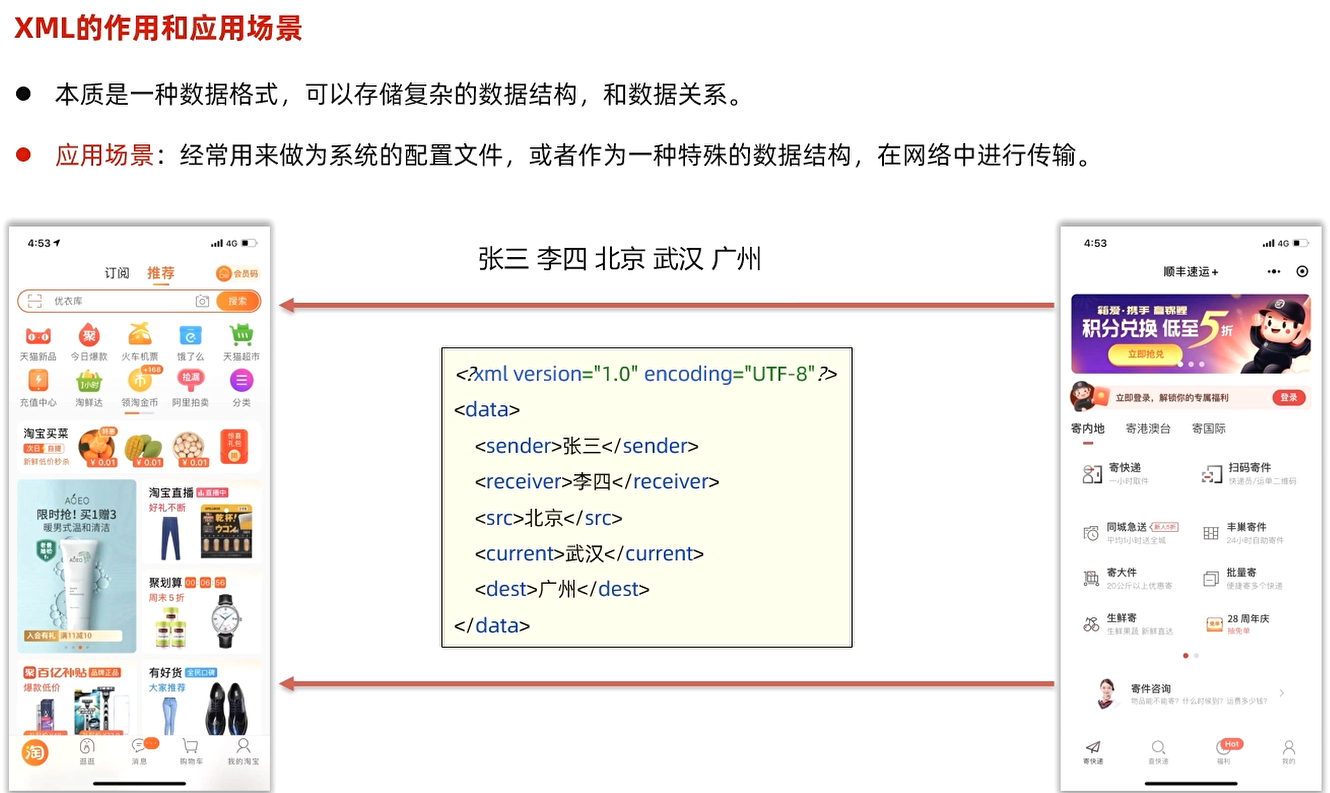
实际上目前在项目开发中我们用JSON格式存储数据的情况比较多,更简洁。
3.2 读取XML文件中的数据
我们可以用dom4j来解析XML
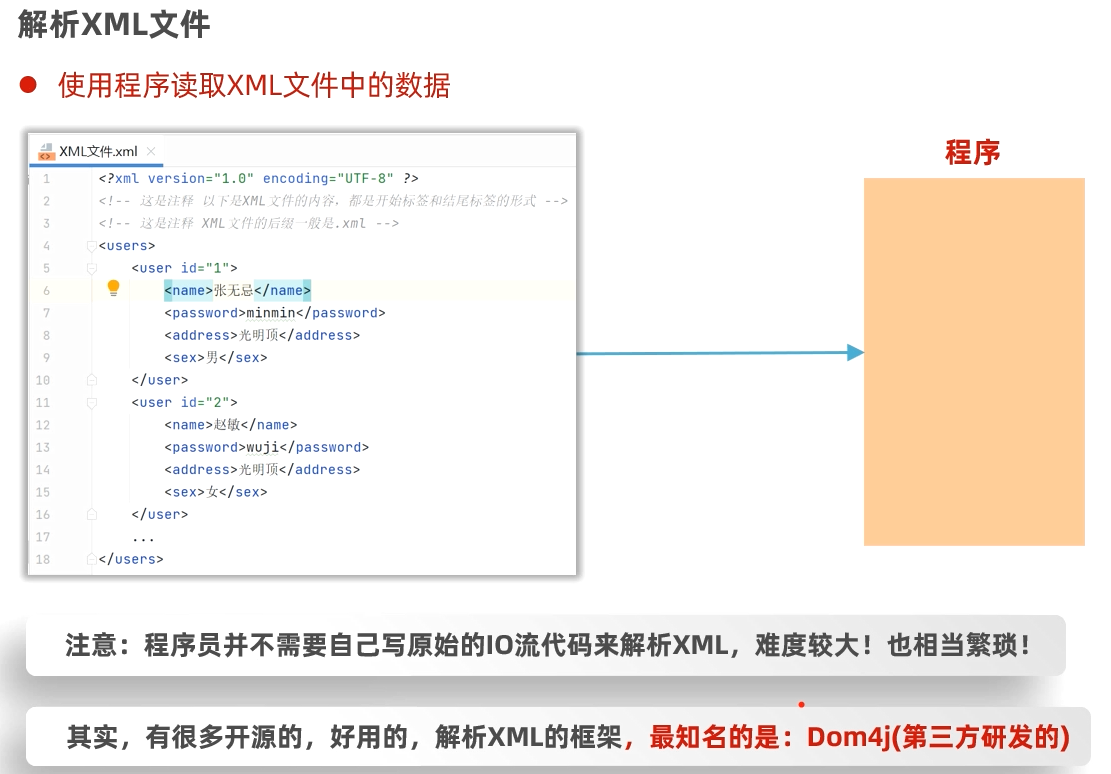
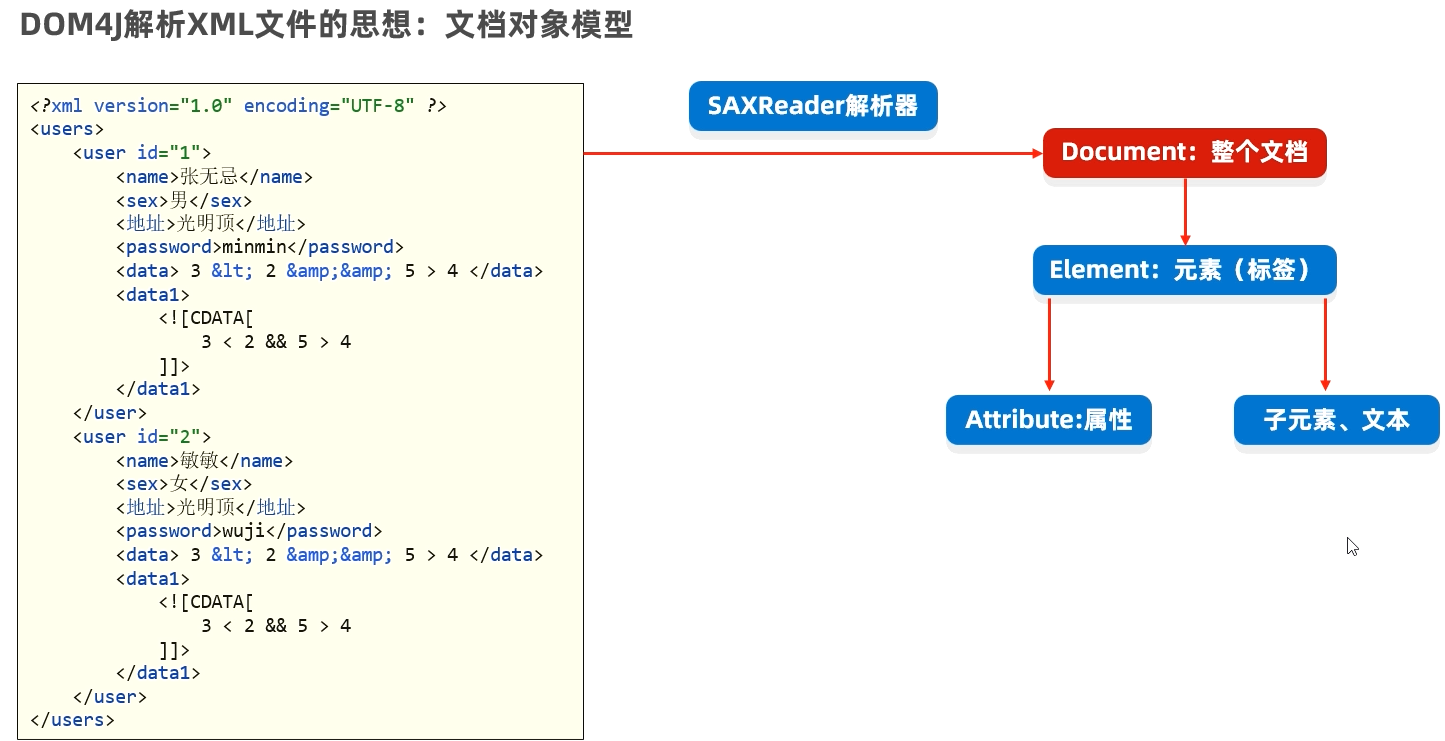
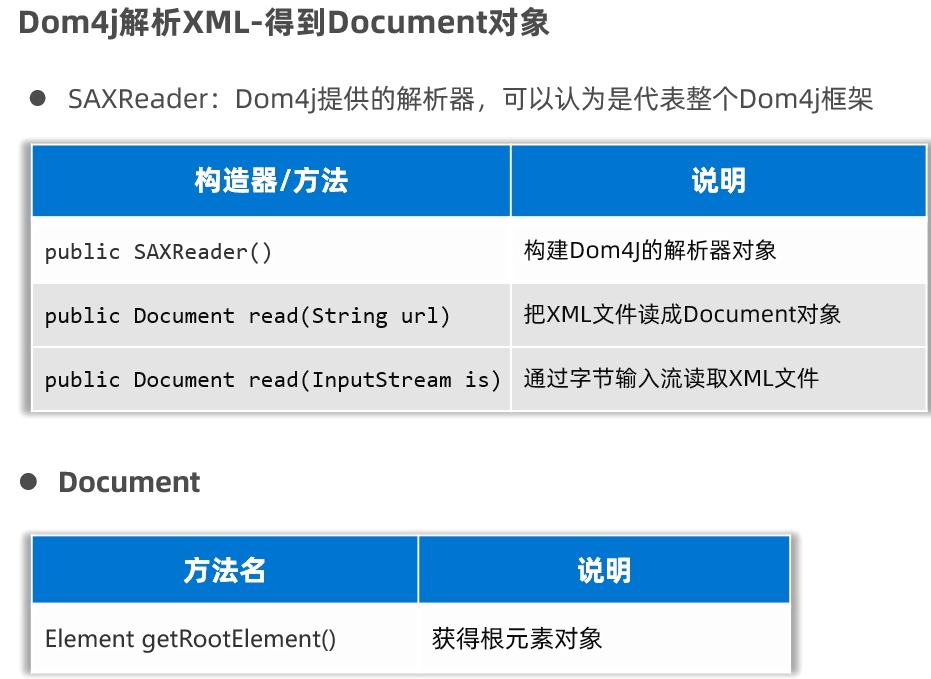
// 目标:解析XML文件:使用Dom4j框架。
// 1、创建一个SaxReader解析器对象
SAXReader saxReader = new SAXReader();// 2、把xml文件读成一个Document文档对象。
Document document =saxReader.read("day11-special-file-log-code\\src\\Contact.xml");// 3、文档对象中包含了XML的全部数据,提供了方法获取数据Element rootElement = document.getRootElement();System.out.println(rootElement.getName());目前能 rootElement.getName() 能得到的就是xml文件中的根元素,如:<users>
下面我们可以用Element提供的方法来提取子元素
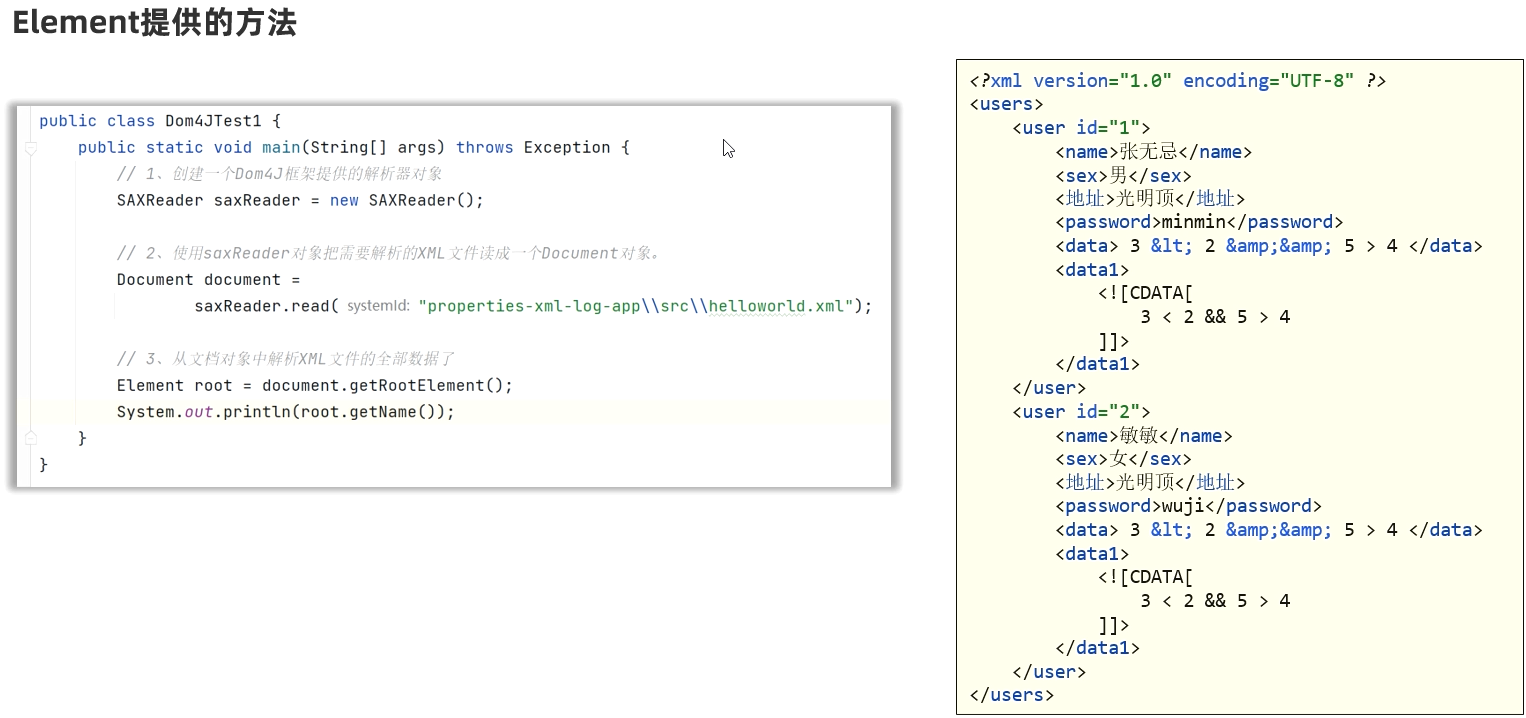
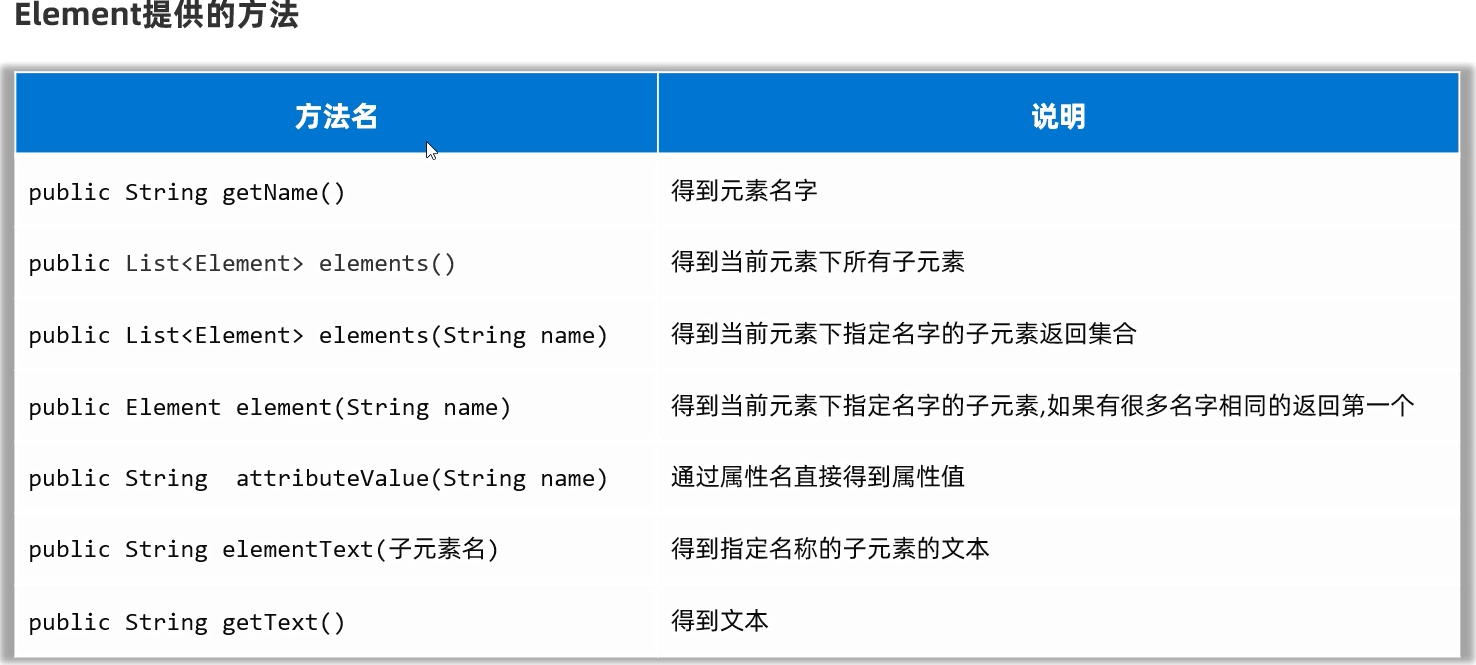
package com.itheima.d2_xml;import org.dom4j.Attribute;
import org.dom4j.Document;
import org.dom4j.Element;
import org.dom4j.io.SAXReader;import java.util.List;public class Dom4JTest1 {public static void main(String[] args) throws Exception {// 目标:解析XML文件:使用Dom4j框架。// 1、创建一个SaxReader解析器对象SAXReader saxReader = new SAXReader();// 2、把xml文件读成一个Document文档对象。Document document =saxReader.read("day11-special-file-log-code\\src\\Contact.xml");// 3、文档对象中包含了XML的全部数据,提供了方法获取数据Element rootElement = document.getRootElement();System.out.println(rootElement.getName());// 4、提取子元素对象//提取所有的子元素对象//List<Element> sonEles = rootElement.elements();//只要contactList<Element> sonEles = rootElement.elements("contact");for (Element sonEle : sonEles) {System.out.println(sonEle.getName());}System.out.println("---------------------------------------");// 指定获取单个子元素对象,父元素拿子元素只能拿一级子元素Element userEle = rootElement.element("user");System.out.println(userEle.elementText("name"));//提取到name的值System.out.println("---------------------------------------");Element contactEle = rootElement.element("contact"); // 默认拿第一个contact!System.out.println(contactEle.elementText("name"));//拿到只第一个contact的子元素name中的数据// 5、提取子元素的属性对象。//contactEle在前面默认拿到的是第一个contactAttribute idAttr = contactEle.attribute("id");System.out.println(idAttr.getName());//idSystem.out.println(idAttr.getValue());//1// 直接拿属性值,比上面的方法更简洁System.out.println(contactEle.attributeValue("id"));//直接拿到 1// 6、文本值// 通过父元素拿到子元素文本值System.out.println(contactEle.elementText("name"));System.out.println(contactEle.elementTextTrim("name")); // 去掉前后空格输出值// 先拿到元素对象,再提取其文本值Element emailEle = contactEle.element("email");System.out.println(emailEle.getText());System.out.println(emailEle.getTextTrim()); // 去掉前后空格}
}
dom4j解析案例
package com.itheima.d2_xml;import org.dom4j.Document;
import org.dom4j.Element;
import org.dom4j.io.SAXReader;import java.util.ArrayList;
import java.util.List;public class Dom4JTest2 {public static void main(String[] args) throws Exception {// 目标:解析XML文件:使用Dom4j框架。// 1、创建一个SaxReader解析器对象SAXReader saxReader = new SAXReader();// 2、把xml文件读成一个Document文档对象。Document document =saxReader.read("day11-special-file-log-code\\src\\Contact.xml");// 3、文档对象中包含了XML的全部数据,提供了方法获取数据Element rootElement = document.getRootElement();// 4、准备一个联系人集合存储联系人对象List<Contact> contacts = new ArrayList<>();// 5、提取全部一级联系人元素对象List<Element> sonEles = rootElement.elements("contact");// 6、遍历子元素对象for (Element sonEle : sonEles) {// 7、每个子元素是一个联系人对象,创建联系人对象,封装数据Contact contact = new Contact();// 注入数据。contact.setId(Integer.valueOf(sonEle.attributeValue("id")));contact.setName(sonEle.elementTextTrim("name"));contact.setGender(sonEle.elementTextTrim("gender").charAt(0));contact.setEmail(sonEle.elementTextTrim("email"));// 8、存入到集合中去contacts.add(contact);}System.out.println(contacts);}
}注意从xml文件中获取到值以后为对象赋值时注意数据类型转换
3.3 XML的创建
那么我们如何使用程序把数据写出到XML文件中去?不建议用dom4j做
推荐直接把程序里的数据拼接成XML格式,然后用IO流写出去!
package com.itheima.d2_xml;import java.io.PrintStream;public class Dom4JTest3 {public static void main(String[] args) throws Exception {// 目标:写一个xml的数据出去StringBuilder sb = new StringBuilder();sb.append("<?xml version=\"1.0\" encoding=\"UTF-8\"?>\r\n");sb.append("<user>\r\n");sb.append("\t<name>").append("张三").append("</name>\r\n");sb.append("\t<age>").append("12").append("</age>\r\n");sb.append("\t<sex>").append("男").append("</sex>\r\n");sb.append("</user>\r\n");PrintStream ps = new PrintStream("day11-special-file-log-code/src/users3.xml");ps.println(sb);ps.close();}
}
3.4 补充:约束XML文件的编写
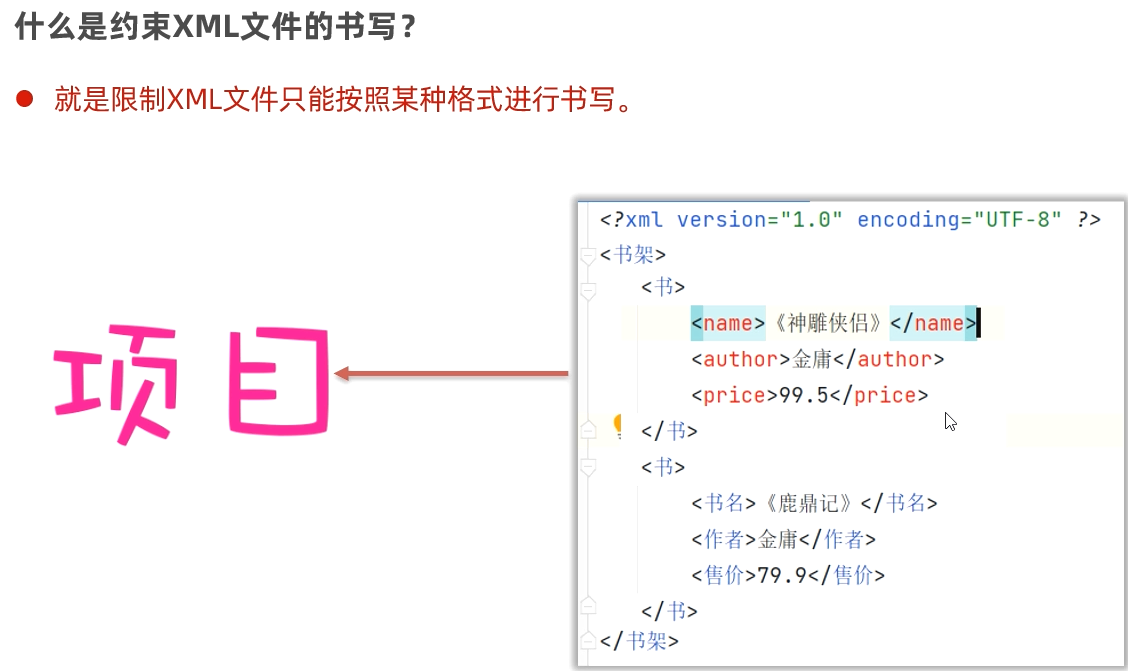
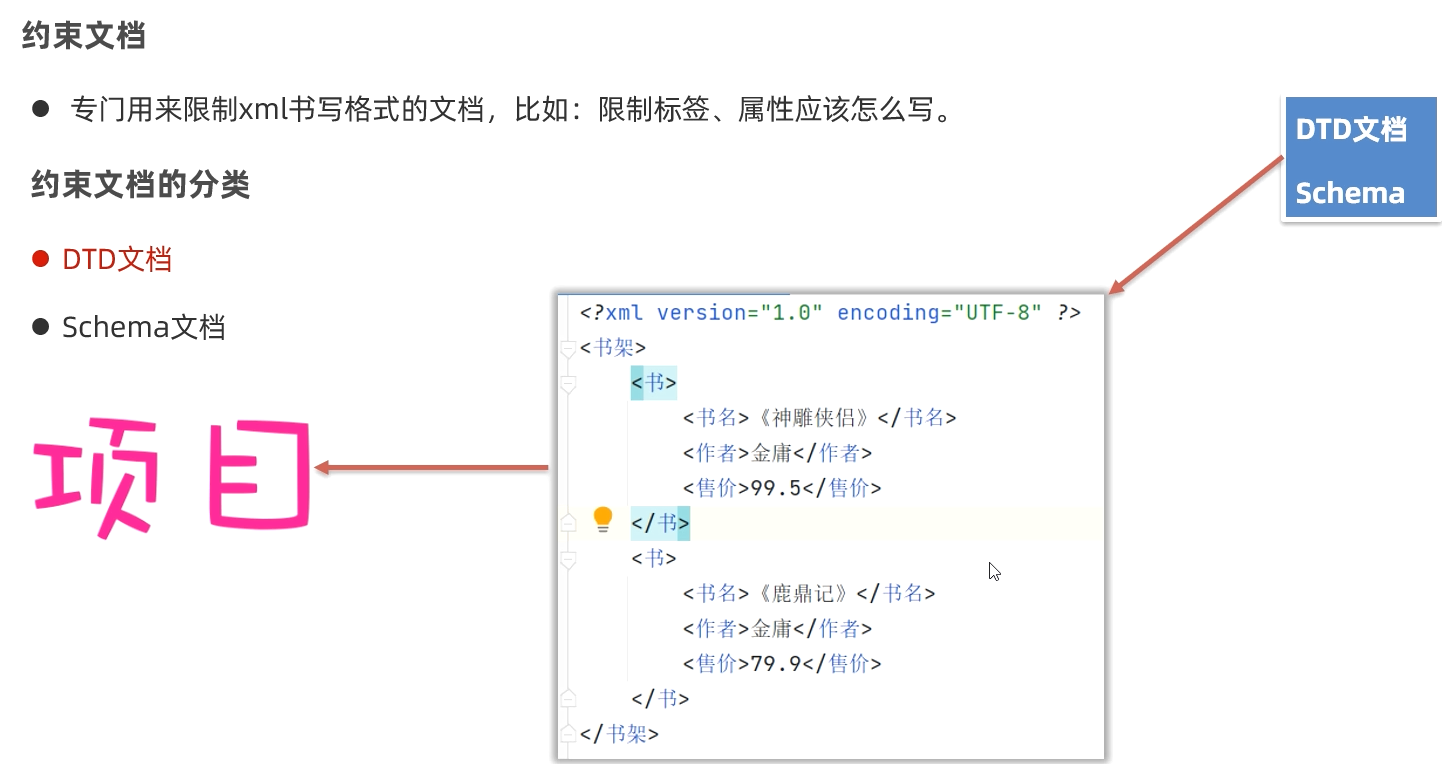
3.4.1 XML文档约束-DTD的使用(了解)
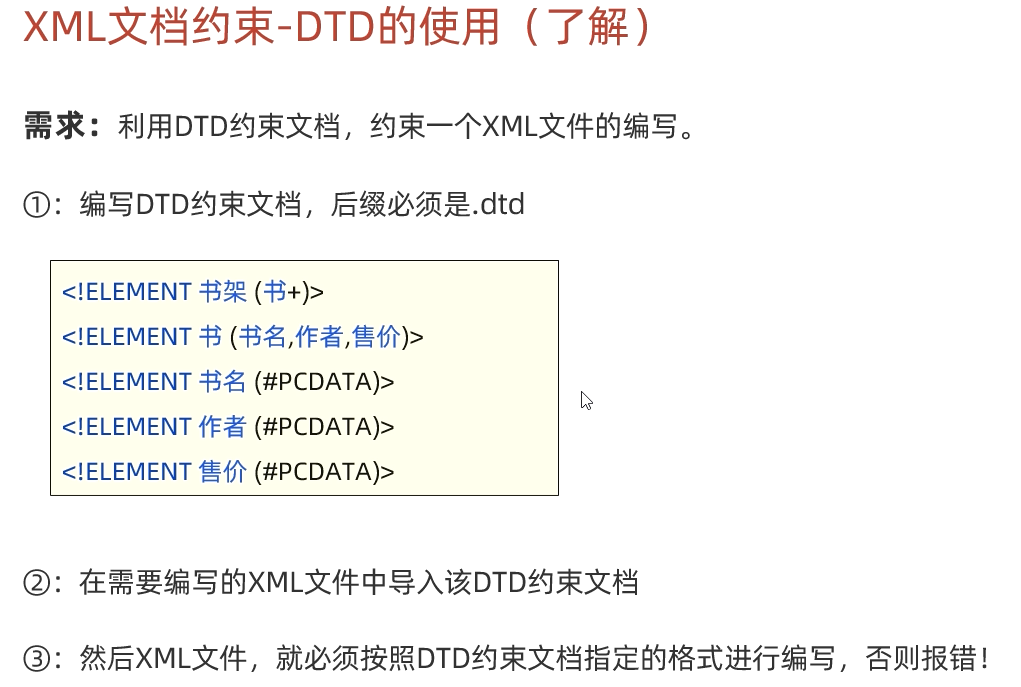
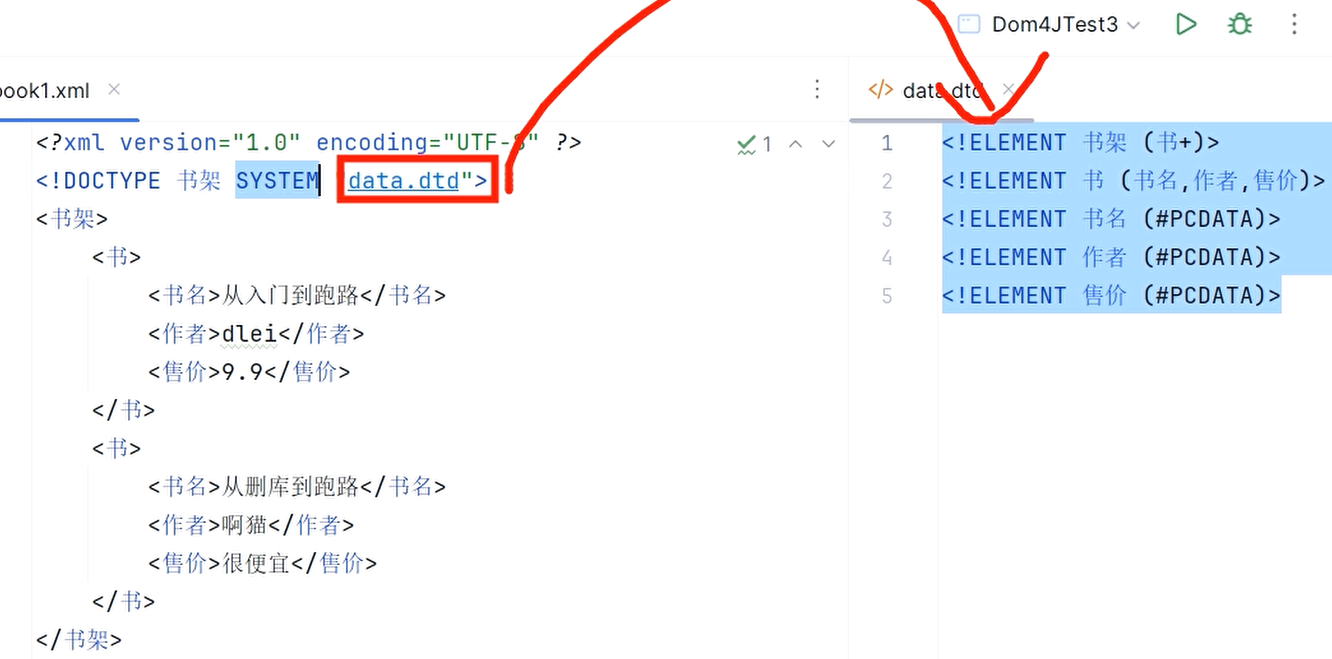
DTD也有局限性:它可以约束XML文件的编写,但是不能约束具体的数据类型
3.4.2 XML文档约束-schema的使用(了解)
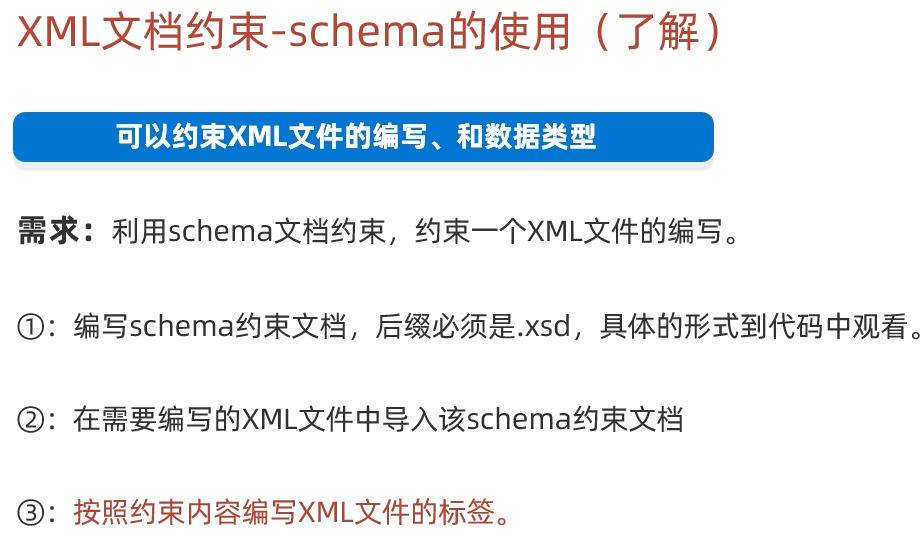
<?xml version="1.0" encoding="UTF-8" ?>
<schema xmlns="http://www.w3.org/2001/XMLSchema"targetNamespace="http://www.itcast.cn"elementFormDefault="qualified" ><!-- targetNamespace:申明约束文档的地址(命名空间)--><element name='书架'><!-- 写子元素 --><complexType><!-- maxOccurs='unbounded': 书架下的子元素可以有任意多个!--><sequence maxOccurs='unbounded'><element name='书'><!-- 写子元素 --><complexType><sequence><element name='书名' type='string'/><element name='作者' type='string'/><element name='售价' type='double'/></sequence></complexType></element></sequence></complexType></element>
</schema>4.日志技术
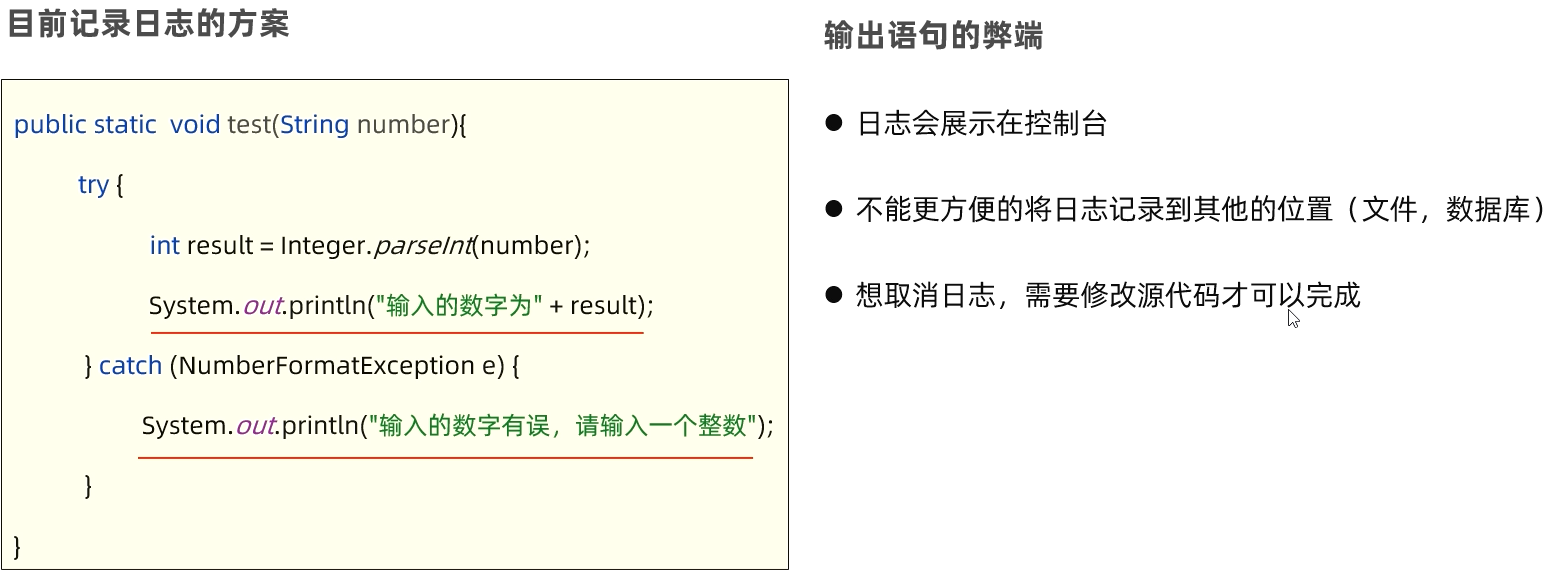
- 可以将系统执行的信息,方便的记录到指定的位置(控制台、文件中、数据库中)。
- 可以随时以开关的形式控制日志的启停,无需侵入到源代码中去进行修改
4.1 日志技术的体系结构
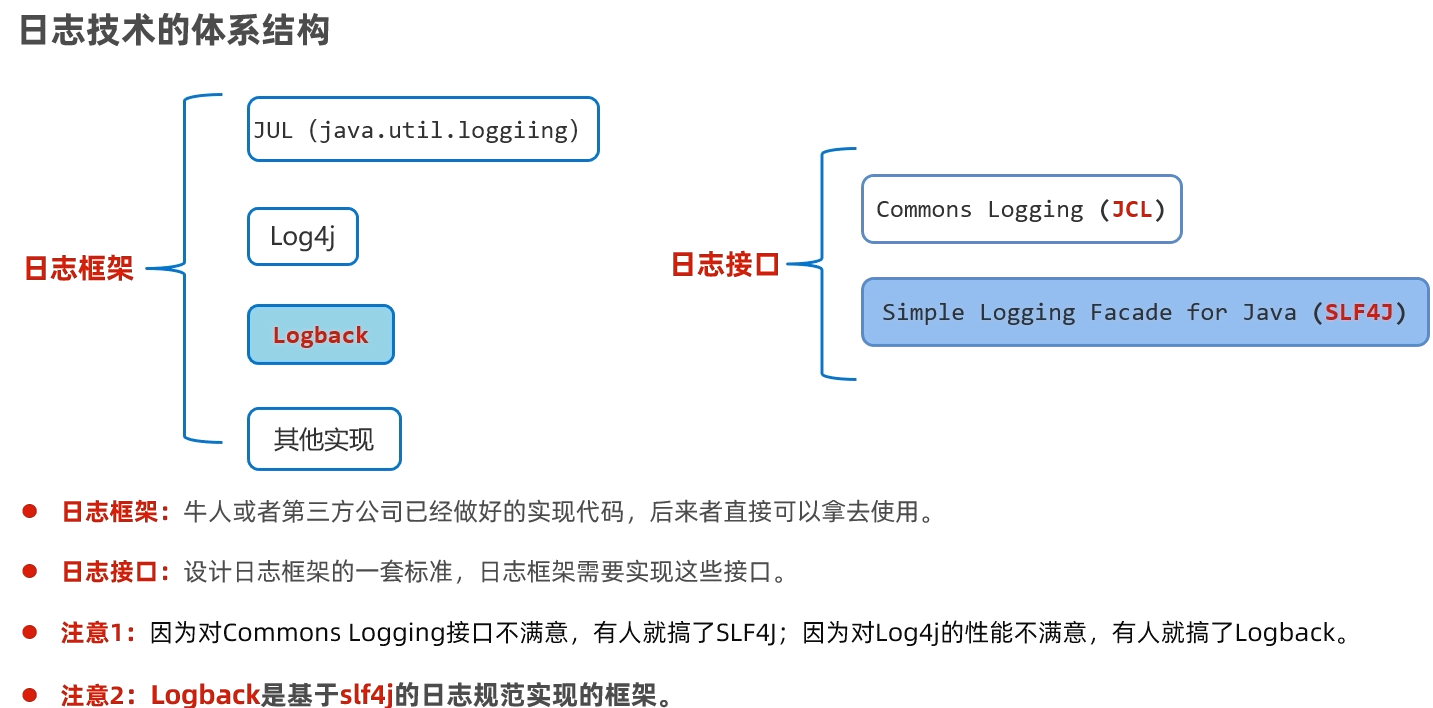
4.2 Logback日志技术快速入门
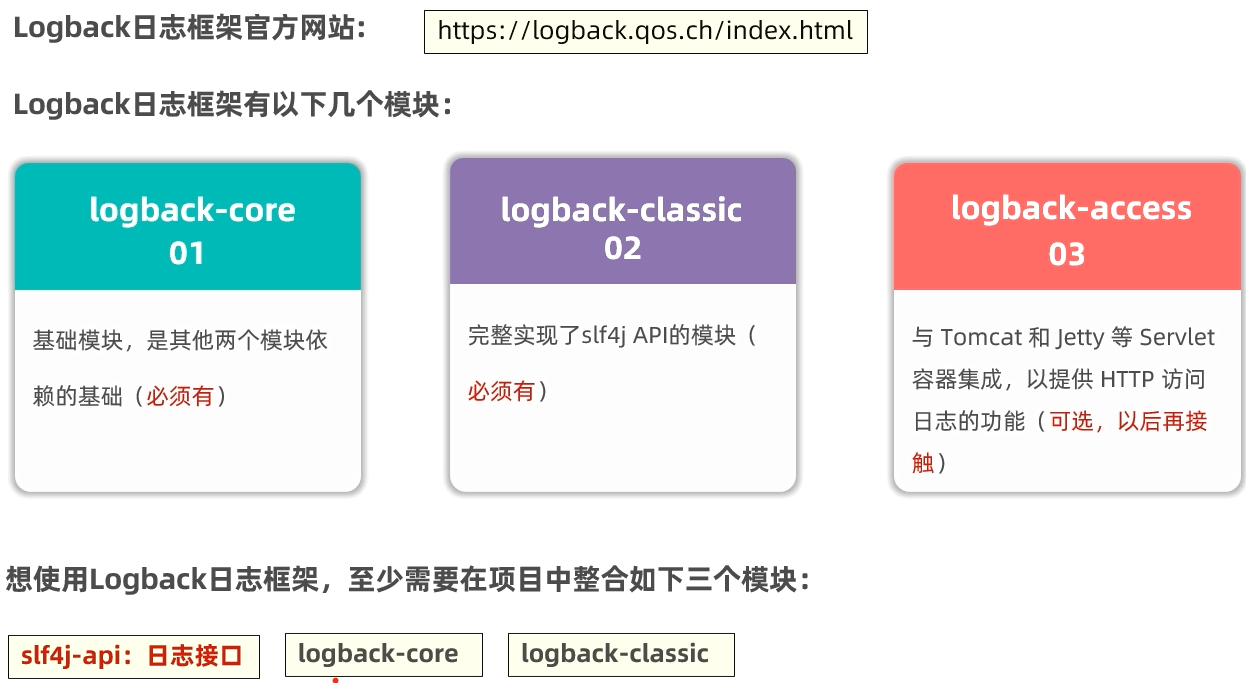
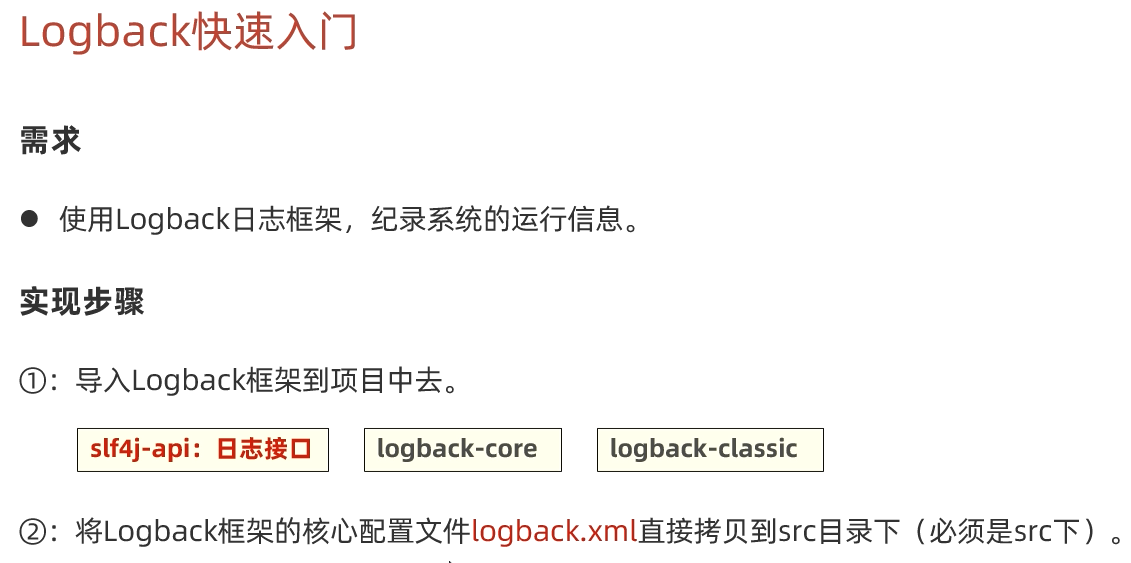
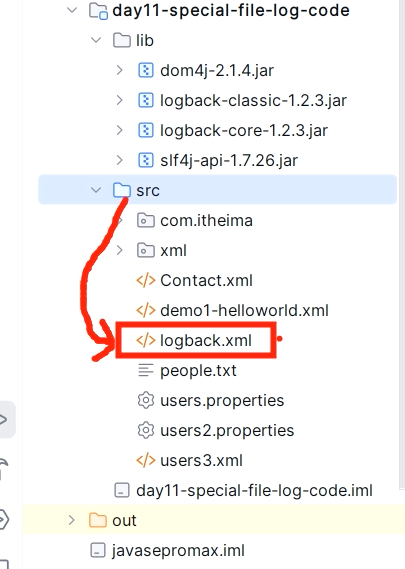
package com.itheima.d3_logback;import org.slf4j.Logger;
import org.slf4j.LoggerFactory;public class Test {// 1、创建一个Logback框架的Logger日志对象,来记日志。public static final Logger LOGGER = LoggerFactory.getLogger("Test.class");public static void main(String[] args) {try {LOGGER.info("除法开始了。。。。。");chu(10, 0);LOGGER.info("除法执行成功了。。。。。");} catch (Exception e) {LOGGER.error("除法执行失败了:" + e.getMessage());}}public static void chu(int a, int b) {LOGGER.debug("参数a:" + a);LOGGER.debug("参数b:" + b);int c = a / b;LOGGER.info("结果c是:" + c);}
}
在控制台和log文件中都会记录日志

 4.3 日志技术的核心配置文件
4.3 日志技术的核心配置文件
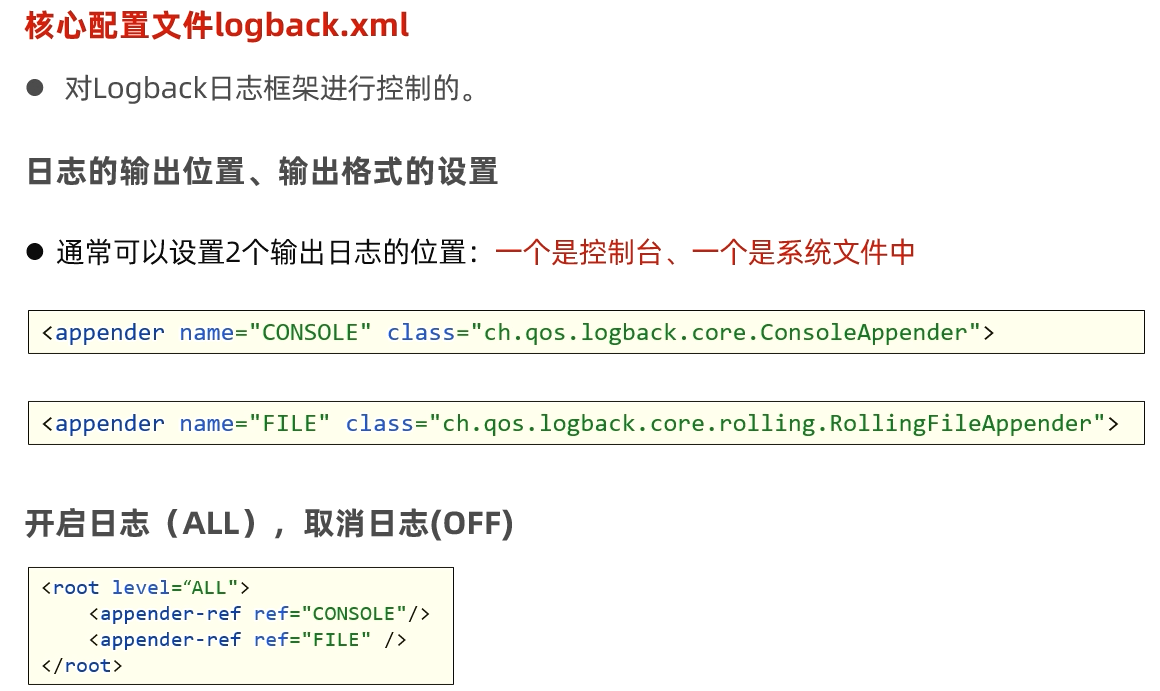
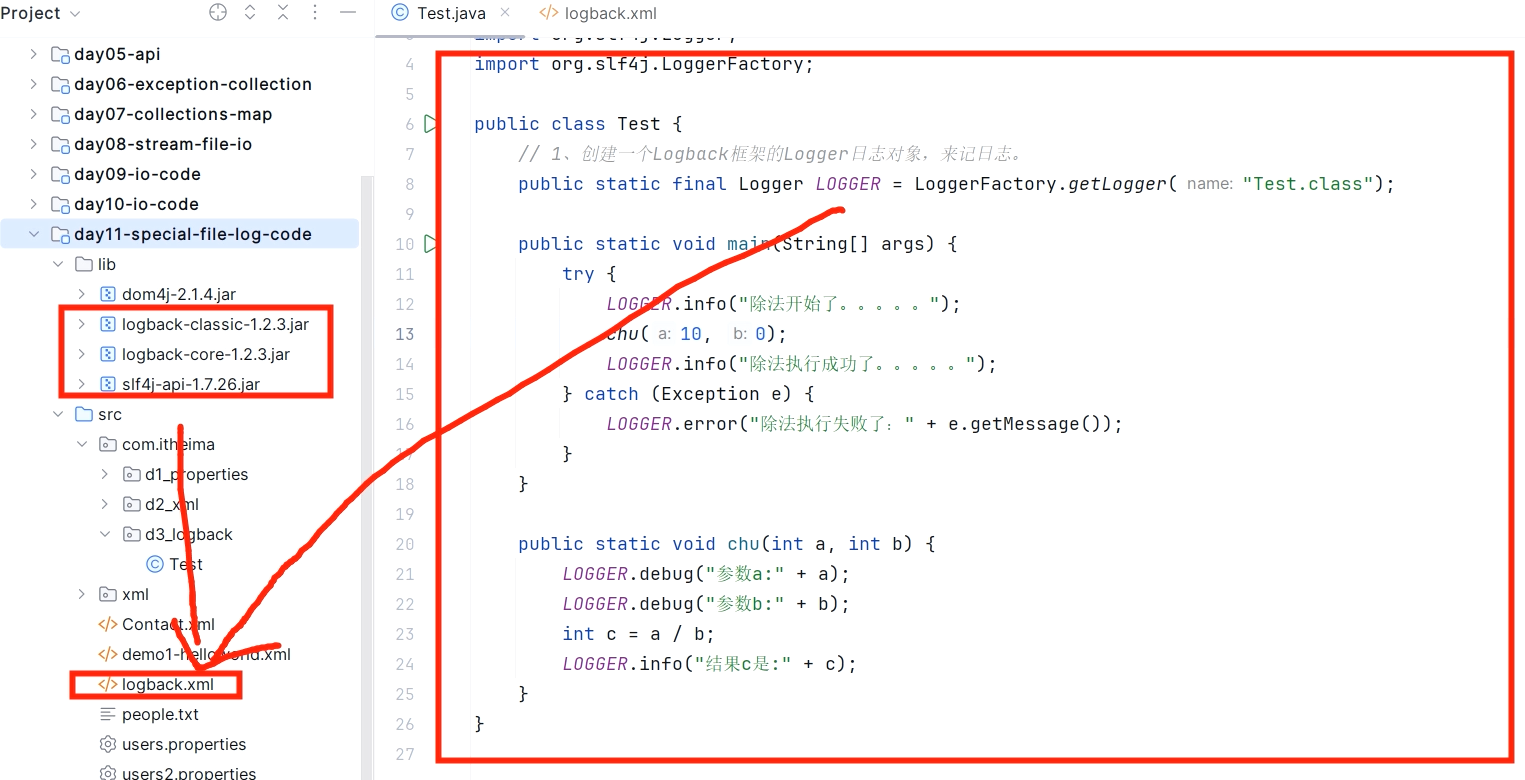
这个核心配置文件logback.xml 一定要配置在src下,他是整个logback日志框架的闸口,当我们在用这个logback框架记日志时,所有的日志对象都会通过这个核心配置文件来进行整个项目的管控
<?xml version="1.0" encoding="UTF-8"?>
<configuration><!--CONSOLE :表示当前的日志信息是可以输出到控制台的。--><appender name="CONSOLE" class="ch.qos.logback.core.ConsoleAppender"><!--输出流对象 默认 System.out 改为 System.err--><target>System.out</target><encoder><!--格式化输出:%d表示日期,%thread表示线程名,%-5level:级别从左显示5个字符宽度%msg:日志消息,%n是换行符--><pattern>%d{yyyy-MM-dd HH:mm:ss.SSS} [%-5level] %c [%thread] : %msg%n</pattern></encoder></appender><!-- File是输出的方向通向文件的 --><appender name="FILE" class="ch.qos.logback.core.rolling.RollingFileAppender"><encoder><pattern>%d{yyyy-MM-dd HH:mm:ss.SSS} [%thread] %-5level %logger{36} - %msg%n</pattern><charset>utf-8</charset></encoder><!--日志输出路径--><file>D:/log/itheima-data.log</file><!--指定日志文件拆分和压缩规则--><rollingPolicyclass="ch.qos.logback.core.rolling.SizeAndTimeBasedRollingPolicy"><!--通过指定压缩文件名称,来确定分割文件方式--><fileNamePattern>D:/log/itheima-data-%i-%d{yyyy-MM-dd}-.log.gz</fileNamePattern><!--文件拆分大小--><maxFileSize>1MB</maxFileSize></rollingPolicy></appender><!--1、控制日志的输出情况:如,开启日志,取消日志all 代表打印全部日志off 关闭全部日志debug info error--><root level="all">
<!-- 在控制台打印日志--><appender-ref ref="CONSOLE"/>
<!-- 在文件中打印日志--><appender-ref ref="FILE" /></root>
</configuration>4.4 日志级别
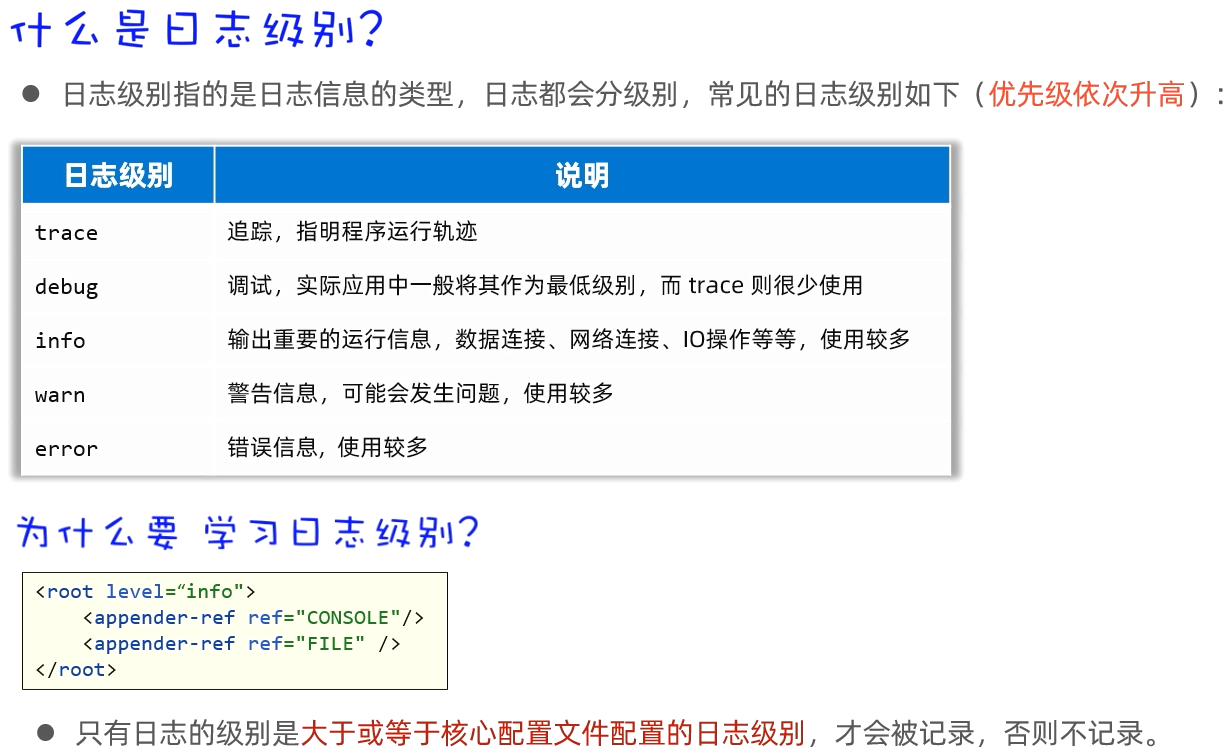
核心配置文件配置的日志级别在以下代码中:
<root level="all">
<!-- 在控制台打印日志--><appender-ref ref="CONSOLE"/>
<!-- 在文件中打印日志--><appender-ref ref="FILE" /></root>只会打印大于或等于level的日志级别,也可以不写,不写的话就会默认配置debug级别。

